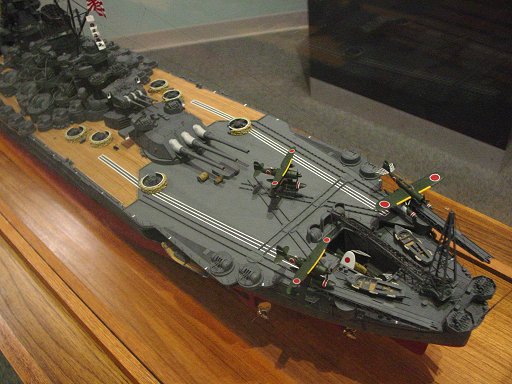
Model of Yamato Class Battleship - note float planes and hanger
Aircraft Carrier Tactics of World War II
There was a great transformation in aircraft carrier tactics beginning in August 1942. Although naval warfare naturally favors the attack, in just a short time new weapons and technology radically improved the power of the defense. By 1944, US Navy carriers were seriously threatened only by kamikazes - human-guided missiles - and even they failed to sink a single large American carrier.
Aircraft carriers were first developed in the 1920s, and although early air power partisans made extravagent claims, the threat to battleships was vastly over-stated. The bombing and sinking of the battleship Ostfriesland took two days despite its being stationary and having damaged bulkheads - further testing was required. The battleship Iowa was fitted with radio control to allow for evasive maneuvering - only two of eight bombs dropped from 4,000 feet hit the ship. The British also experimented with bombing a radio controlled battleship - there were no hits out of 114 bombs dropped while tests of anti-aircraft guns resulted in 75% hits on targets at an altitude of 4,000 feet. Armor against air attack was also added to battleships, and in a 1924 test, a 1,440 pound shell dropped from 4,000 feet was unable to pentrate the deck armor. (McBride 145-7) As a result of studies like these, the early mission for carrier aircraft was primarily spotting for the big guns of the battleships. In the interwar era, the US Navy concluded that aerial spotting improved gun accuracy by two to six times. (Hone 81) With such a great advantage, spotters became targets themselves requiring fighter protection. In the 1920s and 30s, detection of enemy planes was limited to visual detection by defending aircraft - a difficult proposition. Radios did not yet exist in aircraft, further complicating the situation. (Wildenberg 86) Strikes from aircraft on ships were possible, but as late as 1931 airstrikes from carriers were still cumbersome. Fleet Problem XII included airstrikes from Lexington and Saratoga on "enemy" ships, but the carriers had to close to 40 to 75 miles to launch an attack, a tricky proposition considering the speed of enemy ships and the need to turn into the wind to launch a strike. The Navy concluded that carriers had to operate under the protection of battleships. An exercise later in the year showed the difficulty of dive bombing a target moving evasively. (Wildenberg 92, 94) Exercises in 1933 raised doubt of the usefulness of torpedo bombers, and exercises the next year suggested that torpedo bomber attacks were destined to fail because of anti-aircraft fire. (Wildenberg 101, 107) Naval aviation spurred considerable study in Japan also - but there were few clear answers. During exercises in 1939 and 1941, Japanese dive bombers scored hits 53-55% of the time, but many in the Japanese Navy believed that anti-aircraft fire would lower wartime figures to just 1/3 that figure. (Peattie 141-3) In light of these unanswered questions, it was unwise for a navy to tie its future solely to either carriers or the traditional battle line. (Hone 178) Despite the murky situation, more carriers were built by both sides, and airplane development continued. By the beginning of the Second World War, there were two main schools of thought about naval aviation. The first was that carrier based planes would scout for the main battleship fleet, soften up the enemy fleet, and spot for the big guns of the battleships. With 20-20 hindsight it is easy to see the flaws in this theory, but at the time the vast majority of the navy's firepower came from its guns, with long range aviation ordnance accounting for only a small fraction of the total. The second theory, a radical one, was that carrier aircraft would destroy everything afloat. (Hughes 88) Combat experience would show that both of these theories were extreme.
Aviation technology was improving dramatically in the interwar era. The Curtiss F8-C4 of 1929 was powered by a 450hp engine and could carry 200 pounds of bombs less than 400 miles. In contrast the SBD-2 of 1941 was powered by a 1,000hp engine and could carry 1,000 pounds of bombs nearly 1,000 miles - a dramatic improvement. By the late 1930s, navies understood that the first target of carrier planes should be enemy carriers. When World War II broke out in 1939, little was learned about carrier tactics because Germany and Italy had no carriers. Although a lucky hit by an air launched torpedo had damage the Bismarck's rudder, dooming her, and three Italian battleship had been sunk by air attack at Taranto, other events gave contrary indications. (McBride 201) In the 1940 Norway campaign, German bombers scored less than 1% hits against British ships, and a short time later two German battleships sank a British carrier, HMS Glorious, in a surface engagement. When the Pacific War started in December 1941, both Japan and the United States had little idea how the war would be fought, but they still had to formulate doctrine - a doctrine predicated on assumptions about airstrikes. Could an airstrike from one carrier sink several enemy carriers or less than one? The answer affected how carrier forces were organized and used. If we assume that a strike from one carrier could sink one enemy carrier - an assumption vindicated by Coral Sea and Midway - we can model the results of battle. In "Fleet Tactics", Wayne Hughes shows us on pages 94-95 the likely results of such battles - depending on who strikes first. In the table below, the top row is the number of carriers on each side at the start of the battle, so 2/2 means that Japan and the US both have 2 carriers. If Japan strikes first, they sink both American carriers - so 2/0 is the result. If the US strikes first, 0/2 is the result. Clearly, striking effectively first is key to victory.
Initial Number of Carriers (Japan/US)
| 2/2 | 4/3 | 3/2 | 2/1 | 3/1 | |
| Japanese strike first | 2/0 | 4/0 | 3/0 | 2/0 | 3/0 |
| US strikes first | 0/2 | 1/3 | 1/2 | 1/1 | 2/1 |
| Japanese and US strike simultaneously | 0/0 | 1/0 | 1/0 | 1/0 | 2/0 |
In reality, there can be more than one strike from each side. If we look at Midway, for example, a first strike by the Americans from 3 carriers sinks 3 of 4 Japanese carriers. A strike from the remaining Japanese carrier sinks an American carrier, and a second American strike sinks the remaining Japanese carrier. In this case, the model represents historical reality.
Before the battles of 1942, many American naval aviators believed that an air strike from one carrier could sink two to three enemy carriers. Anti-aircraft defenses were weak. Because of this, it was thought that carriers should be dispersed in the theory that if the enemy could only find one carrier, they could only sink one carrier. Massing all the carriers in one screen would endanger them all unnecessarily. (Hughes 103) The US Navy kept their carriers within supporting distance. At Midway, the two carrier task forces were kept 25 miles apart - far enough away to make it unlikely that they would be be detected by the same scout plane, but close enough so that each group's fighter screen could support the other. (Lundstrum 323) Prior to the war the Japanese had also struggled to address the issue of dispersal or concentration. Seeing that radio messages were necessary for a dispersed force to attack, they saw that this would sacrifice the element of surprise. Ultimately the Japanese compromised, forming divisions of two carriers each with divisions spread out over vast stretches of ocean, operating in a V-shaped formation designed to encircle the enemy. (Peattie 75, 148)Japanese carriers made air strikes on US bases in late 1941, but it took until 1942 for combat between carriers. In 1942, carrier forces were split so that each carrier was escorted by approximately two cruisers and three destroyers. (Wukovits 39) These escorts surrounded the carrier at a distance in a circular "wagon wheel" formation. If the force needed to change direction, each ship would turn to the proper heading, maintaining the circular formation. This screen of escorts protected the valuable carrier with anti-aircraft fire. It would also fight off any surface ships which reached the task force and protect the carrier from submarine attack. (Hughes 88-90) This formation was an evolution of a formation used for surface cruising and scouting before deployment into battle line. (Hone 73) The ships were designed and manufactured so that their speeds were roughly comparable, and a carrier group could travel at about 30 knots.
Battleships were still a great danger to the carrier task force. At night, it was impossible for a carrier group to detect a force of battleships. Within the period of one night, a force of battleships could traverse the 200 mile range of aircraft and be within gun range of the carrier task force before morning. (Hughes 105) Even in daylight, where carriers were often forced to turn into the wind to launch and land planes, the threat from battleships was all too real. The decisive battle of Midway could have been very different had the Japanese deployed their numerically superior battleships in the front, and not in the rear, of their naval force. Still seeing the carriers as scouts for the battleships, their battleships would not enter the fray. On both sides, however, submarines were seen as important screening vessels for the carrier fleet, but because they were slower than surface ships, they had to move into position well before the carrier task forces. In several battles subs were able to sink enemy carriers, and for the Americans they were always useful in recovering downed airmen.
Carrier based planes were of three types: torpedo bombers, dive bombers, and fighters. Torpedo bombers carried a single torpedo which was dropped and propelled itself toward the target. In 1942, the United States used the Devastator torpedo bomber, which was being replaced by the Avenger torpedo bomber. (Reynolds 145) Dive bombers flew directly over the target, made a steep dive toward the target and released a bomb, then pulled out of the dive. The Dauntless dive bomber could carry 1,200 pounds of bombs. (Reynolds 79) The Wildcat fighter had more features to protect the pilot, but the plane was inferior to the Japanese Zero fighter in other ways. It was slower, had a shorter range, and couldn't climb as fast. (Reynolds 81) Due to its inferiority in dogfighting, the Americans developed a tactic called the Thach Weave in which two Wildcats flew in formation. If a Zero followed one of the fighters, the Wildcats weaved in and out so that one fighter could get a crossfire on the Zero. (Reynolds 64-5)
| Each US carrier had an air wing of 94 planes. In light of the theories of the strength of the attack, only 25% of these planes were fighters, which intercepted enemy search planes and air strikes and escorted the dive bombers and torpedo bombers on strike missions. The remaining 75% of the air wing were dive bombers and torpedo bombers. (Hughes 102) Since attacking the enemy before he attacked you was of such great importance, the carrier force had to locate the enemy by scouting. To "strike effectively first", you must find the enemy. If the enemy finds you, and you do not find him, everything else is irrelevant. At the first carrier battle, Coral Sea, scouting was poorly done by both sides. American scouting was conducted by the Dauntless dive bomber. Instead of using valuable carrier aircraft, the Japanese often used float planes from battleships and cruisers, an economy measure which didn't always work out as the float planes proved to be inferior to carrier planes as scouts. |

Model of Yamato Class Battleship - note float planes and hanger |
As there was no advantage to remaining on the defense, when the enemy was located, an air strike was usually made immediately. The maximum range for an air strike with dive bombers and torpedo bombers was about 200 miles. These planes were escorted by fighters, but only 25% of a carrier's planes were fighters and some would be retained to protect the fleet. For example, in March 1942 two US carriers made a strike on Japanese ships conducting the invasion of New Guinea. The strike was composed of 48 dive bombers, 25 torpedo bombers, and 18 fighters. Fifteen planes were retained to protect the carriers. (Cressman 41) At Coral Sea, two American carriers sent 54 dive bombers, 21 torpedo bombers, and 24 fighters to strike the Japanese fleet. Forty-three planes were lost out of 99 planes, but a Japanese carrier was sunk. The Japanese sank an American carrier with a force of 69 planes. (Wukovits 37) At Midway, three American carriers sank four Japanese carriers at a cost of one carrier lost. In one instance, an American torpedo bomber force attacked the Japanese without fighter escort and was nearly annihilated, and on the whole casualties were high. After the battle, 126 American planes survived out of 233 planes, a 46% loss rate, and no Japanese planes survived out of 272. (Hughes 97) While making attacks, planes often came from the direction of the sun to make anti-aircraft fire less effective. Torpedo bombers would separate into two groups, approaching enemy ships and dropping torpedoes at 90 degree angles so that no matter evasive maneuvers, on side of the ship would be exposed.
Lacking radar early in the war, the Japanese were forced to use their fighter aircraft on combat air patrol, or CAP, to detect incoming enemy search planes and air strikes. This inefficient method could easily fail, especially in cloudy weather, and it meant that the fighters were spread out and not concentrated for an organized defense when an enemy airstrike arrived. With just a five mile visual range, there was little time to come to react. In contrast, American radar gave warning of enemy aircraft out to 80 miles. (Lundstrum 89-91, 228) Although radar was a big advantage, early on American CAP planes were frequently sent to confront friendly approaching aircraft which did not have Identification - Friend or Foe (or IFF) gear. On at least one occasion, Japanese planes were allowed to approach in the confusion. (Lundstrum 73) For the slow climbing Wildcat fighters, an altitude advantage in dogfights was critical. CAP was usually deployed on at least two different altitudes because attackers approached at high and low levels, and it was impractical for a high altitude fighter to intercept low level enemy planes then return to high altitude. Good coordination was important too, with interception best as far from the carrier as possible, 30 miles or so, to give the fighters maximum time to disrupt the enemy formation, preferably meeting it before the dive and torpedo bombers split up. (Lundstrum 304, 443)
By World War II, US Navy ships included a Combat Information Center to deal with the array of information involved in battle. Carriers included a fighter direction officer to coordinate the interception of enemy aircraft. These officers were trained at schools to learn the skills necessary - the training even included a British concept, the simulation of aircraft interception where pilots pedaled tricycles equipped with blinders to obscure their view. (Wolters 192) In February 1942, a Japanese air attack on USS Lexington was parried by effective use of radar and fighter direction - two attacks from two different directions were both intercepted and defeated. At Coral Sea in May 1942, the Americans were not as lucky. The fighter direction officer of one carrier had authority to control the planes of both carriers, however there were problems - IFF equipped only half of planes, Yorktown's radar broke, pilots failed to send back information to the fighter direction officer, radio was overused and information was slow to flow as a result. There was no uniform use of terminology or plotting symbols and radar plots were too small. Both US carriers were hit and Lexington was lost. (Wolters 196-198) By Midway in June 1942 improvements had been made. In an attack on Yorktown, only seven of eighteen attacking enemy planes got through. USS Enterprise sent four Wildcats to intercept, and these planes might have saved the Yorktown except that the guns of the lead Wildcat jammed, and a radio message to continue the attack wasn't received. The Yorktown was hit. In a later attack on Yorktown, differing assumptions between the fighter direction officer and the pilots about using either true bearing or magnetic bearing meant that six Wildcats failed to intercept ten torpedo bombers, and two torpedoes struck the Yorktown, dooming her. (Wolters 199-200) Reforms after Midway improved fighter interception, but since Enterprise and Hornet hadn't even been attacked, the Navy believed that dispersion of carriers was better than concentration. In the battles of Eastern Solomons and Santa Cruz, the dispersed American carriers could not coordinate their fighter interception, and Hornet was sunk and Enterprise was badly damaged. (Wolters 201)
Forming and escorting an airstrike was also a difficult proposition. The first option was a "normal departure" in which squadrons organized but the whole group didn't. This could lead to a relatively quick but confused attack. The second option was "deferred departure" in which the whole group organized. This allowed for maximum striking power and protection, but its time consuming nature limited the range of the airstrike. Escorting fighters typically would fly above and somewhat behind the attack planes. Since dive bombers were at a low altitude after their attack, and since torpedo bombers attacked at a lower altitude to begin with, two levels of fighter escort were required. (Lundstrum 194)Early in the war ship losses were high. In the beginning of 1942, Japan had 10 carriers to America's 4. (Reynolds 63) By August 1942, Japan had 4 carriers to oppose only one American carrier. (Reynolds 121) But by August 1942, carrier warfare began to change. Before the war, the United States started production of 24 new large Essex carriers, 9 smaller Independence class carriers, and an even greater number of small, slow escort carriers which were used to support ground operations and provide anti-submarine escort, among other duties. (Reynolds 132) In 1943, the new American carriers began to enter service, but because of high Japanese pilot losses, no carrier on carrier battles ocurred for almost two years. Important changes were taking place, and battle in 1944 would prove very different from that in 1942. Due to factors detailed below, none of the new Essex class carriers were sunk, even to kamikaze attacks late in the war. Damage control was better in the US Navy from the start, and it improved during the war. Japanese carriers had enclosed hanger decks, a feature that prevented disposal of fuel and ammunition while under attack and increased blast pressures from bomb explosions, leading to more damage, especially of the flight deck. Unlike American aviation fuel lines, Japanese ones could not be filled with carbon dioxide, and fuel storage tanks were positioned so that damage to the hull could puncture the tanks and spill fuel. Although the Japanese made efforts to improve damage control during the war, their fuel system and enclosed hanger decks largely negated these efforts. (Peattie 65) The United States also had a great advantage in ship construction. Starting in August 1942, new fast battleships were attached to carrier forces. They were used to bombard shore positions, provide anti-aircraft protection, and they were detached at night to protect against the enemy fleet. New cruisers were especially designed as anti-aircraft gun platforms. (Hughes 105)
New aircraft were introduced, and the composition of air wings also changed. For the November 1943 raid on Rabaul, just over half of the task force's planes were fighters, a clear break from the practices of 1942. (Morison, Breaking 331) In 1944, 65% of US Navy air wings were fighters as opposed to 25% in 1942. The Japanese, in contrast, had changed relatively little, with only 34% of the air wings being fighters. (Hughes 102) The increased number of American fighter planes better allowed a multi-level, or stacked, CAP, which hadn't been as practical early in the war. (Lundstrum 443) New planes also changed carrier warfare, but advancements were much greater for the Americans. In 1943, the Japanese introduced a new dive bomber, but it was little different from past models in that it could carry only 1,000 pounds of bombs, the same as its predecessor. In 1944 the Japanese introduced a new torpedo bomber which flew at 300 mph. American improvements were much more impressive. In 1943, the US introduced the Helldiver dive bomber, capable of carrying 2,000 pounds of bombs, twice that of the Japanese dive bomber. In 1944, the US introduced the much superior Hellcat fighter with a range of 1,300 miles, much better than the 770 mile range of the Wildcat that it replaced. It could also be fitted with bombs and sent on airstrikes after air superiority was achieved. Also new was the Corsair fighter-bomber which could reach 417 mph and could be equipped with rockets and bombs to support amphibious operations. (Reynolds 145-9) Perhaps as important, the US Navy had a vast supply of well trained new pilots while the Japanese never adequately replaced the excellent pilots they lost early in the war - losses attributable in no small part to an emphasis on performance over staying power. Facing inadequate pilots, only 270 Hellcats were lost as they dispatched over 6,000 Japanese planes. (Dunnigan 218)
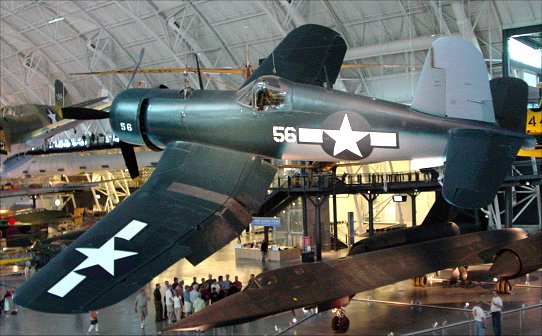 |
| Vought F4 Corsair - intend to replace the Wildcat, the project was delayed, so the F6 Hellcat instead became the standard fighter plane on carriers. Due to the large prop, the wings were shaped to raise the fuselage. The position of the cockpit made carrier landings difficult. |

|
| F6 Hellcat - Originally designed as an improved version of the Wildcat, the plane was in fact a vast improvement. When not needed as fighters, the planes could be armed with 500 pound bombs. |
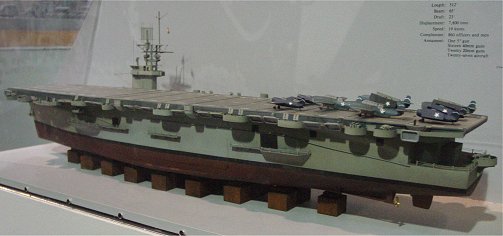 |
| Lunga Point Class Escort Carrier - Small carriers like these, with only 27 aircraft, helped transfer aircraft and performed escort duties, freeing up larger carriers for more important duties. |
 |
| Flight Deck- The US Navy differed from the Japanese in that they refueled, rearmed, and stored aircraft on the flight deck. This, as well as their greater use of folding wings, allowed them to carry more planes, and it mitigated damage from enemy bombs, which often passed right through the wooden deck. |
In 1944, the Japanese could scout to a range of 560 miles and attack at a range of 400 miles. In comparison, the US Navy could scout out to just 350 miles and attack to around 200 miles. (Reynolds 139) Earlier in the war this could have resulted in a decisive Japanese victory, but this American deficiency was largely negated by increased defensive abilities and technologies, not the least of which was the new invention of radar. Radar had many uses and was vitally important in carrier warfare. At Midway, because the Japanese lacked radar, their carriers were crammed with planes refueling and rearming when the decisive American airstrike arrived, leaving them extremely vulnerable at the worst possible time. As we have seen, in addition to detecting attacking enemy aircraft, radar directed intercepting aircraft and anti-aircraft fire and could even locate the enemy fleet. (Hughes 116) The Japanese were lagging in radar technology - their radar had a shorter range, communication with aircraft was poor, and perhaps most importantly, the Japanese lacked a central control system like the American combat information center. (Peattie 198)
Radar was also fitted on 5 inch anti-aircraft shells used for long range anti-aircraft fire. These proximity fuse shells exploded when near the target, instead of at a specific set time with previous fuses, which vastly improved the effectiveness of the guns. (Hughes 116,132) The Bureau of Ordnance estimated that guns firing proximity rounds were four times more effective than guns firing regular time-fused rounds and had an advantage of 8.1 to 3 over the 40mm weapon. (Rowland 286-7) The proximity fuze's performance in battle was impressive. Soon after their introduction, an American task force reported that it downed 91 planes of a 130 plane Japanese formation. (Rowland 287)
For medium range anti-aircraft duty, a quick firing Bofors 40 mm gun with exploding shells was adopted. These guns were later tied in with the fire control system used for 5 inch guns, bringing improvement to both gun types. (Rowland 386) Late in the war, half of all downed aircraft were shot down by the 40mm guns. (Rowland 234) For close-in anti-aircraft protection the newly adopted 20mm Oerlikon gun was 8 to 10 times more effective than the .50 caliber machine gun that it replaced. (Rowland 235) Up until September 1944, 20mm guns accounted for 32% of downed aircraft. New gyroscopic optical fire controllers which calculated a target's rate of change helped make the guns more effective than when used with a standard sight over the gun barrel. Improved fire control systems made AA weapons much more effective. An early indication of this was in October 1942 when the battleship South Dakota shot down ALL 38 planes of an attacking Japanese force. Electrical, as opposed to mechanical fire control computers were developed, and further improvements included the connection of fire control to the ship's radar equipment. This allowed "blind firing" at targets at night or approaching from the sun, a favorite tactic of the time. (Rowland 382, 392)
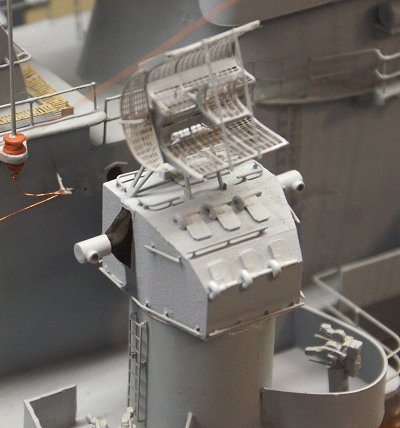 |
| Mark 37 Fire Control System - With a crew of six men, the range finder could collect information from either optical or radar devices and pass it on to a mechanical computer elsewhere on ship that then sent targeting directions to the 5 inch guns. |
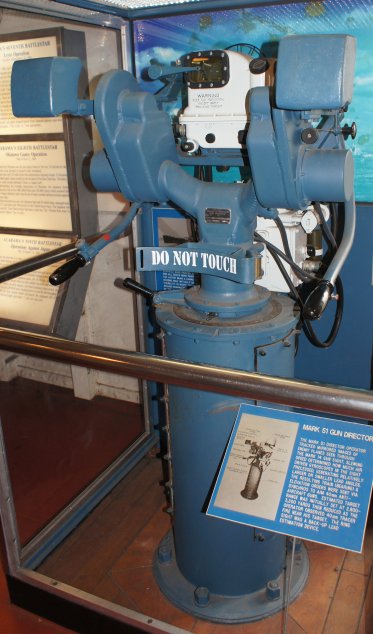 |
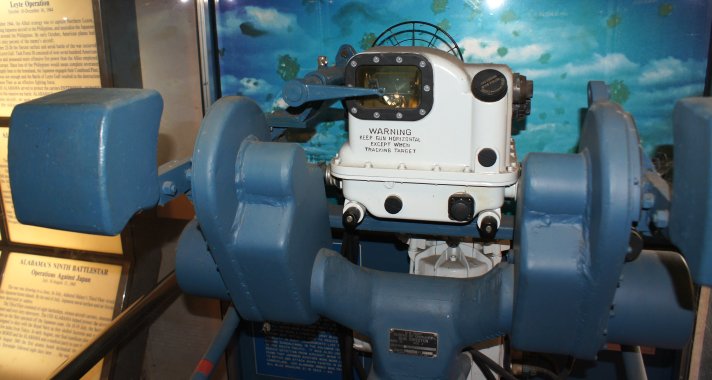 |
Mark 51 Gun Director - Used to direct the 40 mm Bofors anti-aircraft guns, the operator tracked enemy aircraft throught the sight ring, and using gyroscopes, the device determined the speed of the tracking. Assuming a certain range, the speed of the target was estimated, and this information was transmitted to the 40mm guns. |
Anti-aircraft protection increased not just because of the new proximity fuses and the improved QUALITY of the guns and fire control. The QUANTITY of anti-aircraft guns was drastically increased also. The battleship Nevada, an old Pearl Harbor survivor is a good example. It's 5 inch gun armament was doubled from 8 to 16 guns, its four 3 inch guns were replaced by eight 40 mm quad mounts with a total of 32 gun barrels, and its eight .50 caliber machine guns were replaced by forty 20 mm guns. The battleship South Dakota completed during the war is another example. Originally designed to have three 1.1 inch quad mounts, by March 1945 there were instead seventeen 40 mm quad mounts. Instead of its planned twelve .50 caliber machine guns, in March 1945 there were no less than seventy seven 20 mm guns! (Rowland 243, 246) Ships were crammed with so many anti-aircraft weapons that it became impossible to use each of these weapons up to its potential. The improved anti-aircraft defenses could even deal with the kamikaze threat of 1945.

USS Texas pre-war - Note the relative lack of anti-aircraft weapons. |
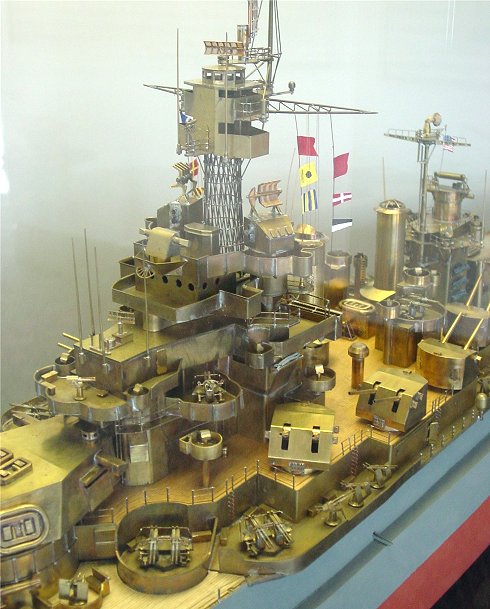
USS Maryland - This brass model gives some idea of the degree to which pre-war battleships were modified with massive additions of AA weapons. |
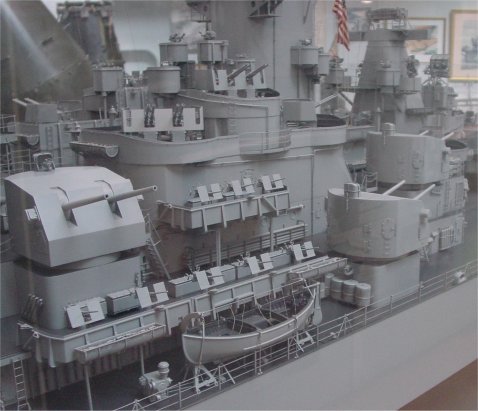 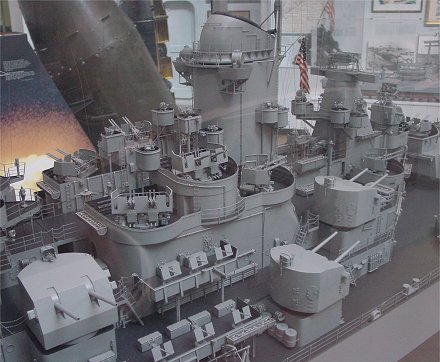
|
| Iowa Class, USS Missouri - Battleships built during the war entered the conflict with many more AA weapons than they were originally designed for. Unlike earlier designs, the Iowas were fast enough to keep up with the carriers. |
 |
| Montana Class - A planned successor to the Iowa Class, the slower, more heavily armed and armored Montanas were to have a fourth 16 inch gun turret and generous anti-aircraft defenses. By 1943, however, it was clear that there were higher priorities, and the class was cancelled, and two of the six planned Iowa Class were never completed. |
Due to increased anti-aircraft capability and the greater numbers of carriers available, new methods of forming carrier task groups was necessary. In the Fifth Fleet, there were now 15 carriers. It would be impossible to control 15 carriers if each had its own protective screen, but this was now unnecessary. As early as 1939, the Navy found ways to mass as many as nine carriers in a single task group and coordinate attacks by twelve air groups. (Hone 103) So by 1944, task groups consisted of four carriers protected by three to five cruisers and twelve to fourteen destroyers. With this method, there were only four separate carrier groups, making the entire carrier force much easier to control while the effective anti-aircraft protection made them safe from enemy attack. It was more difficult to coordinate the air power from within a four carrier task force, which resulted in somewhat clumsy air operations, but the increased defensive power made this a worthy tradeoff. The Japanese had fewer carriers, lacked escorting ships, and had not significantly improved their anti-aircraft defense. Unlike the US fleet, the major Japanese warships were often kept separate from the carriers specifically for use in surface actions, so their anti-aircraft firepower wasn't available to protect the carriers. Therefore, the Japanese provided a screen of 12 much less effective escorts to a group of two carriers. (Macintyre 255-6)
The battles of the Philippines Sea in June 1944 and Leyte Gulf in October 1944 saw the destruction of Japanese naval aviation. Even by the Philippines Sea battle the US fleet could fight more conservatively and be satisfied without actually sinking Japanese carriers - they destroyed Japanese naval air aviation, making the Japanese carriers themselves largely impotent, all the while protecting the beachhead and ensuring operational and strategic victory. While 1942 battles had been fights to destroy carriers, by 1944, the battle was more of one to destroy aircraft. Did the US Navy fully understand this? In reaction to the failure to sink flattops at the Philippine Sea, Nimitz changed priorities for Admiral Halsey at Leyte Gulf, making destruction of the Japanese fleet paramount. Halsey allowed himself to be lured away from the vulnerable troops transports that he was tasked with protecting. Although the Japanese carriers were destroyed, they were nearly merely sacrificial bait. For the Americans, disaster was narrowly averted at the beachhead. (Hughes 102-3) Who should command carrier task forces? Fully in charge until late 1943, non-aviators used carriers conservatively - Spruance for example, thought victory would come from amphibious operations and argued against attacks deep into Japanese waters due to logistical difficulties. He also believed that the Japanese would decline battle unless they saw that it was to their advantage. (McBride 183-4) Aviators complained - Admirals Towers and Sherman argued that carrier task forces should be commanded only by aviators. Ultimately a dual command compromise was reached whereby if an aviator was not in charge of an operation where air power predominated, the chief of staff would be an aviator, and that in the future, commanders would be trained in the use of all arms. (McBride 184, 204-8)
With the Japanese carrier threat eliminated, the US Navy's primary worry was attack from land based aircraft, with kamikazes becoming the greatest threat. The kamikaze threat was different from standard air attacks - small groups at a low altitude made them difficult to detect, and they came from many directions at once, not just from one or two. Electronic interference and IFF failures due to air congestions also posed problems. At Okinawa, radar picket ships helped solve the problem, with fighter direction officers in picket destroyers vectoring interceptions rather than officers in carriers. Picket ships took heavy losses - 15 sunk and 45 damaged out of 206 ships - and the fleet as a whole took heavy losses, but the system worked. Army Air Corps strikes on airfields also helped with kamikaze defense, and perhaps the capture of small outlying islands to establish radar stations might have been a useful option. (Wolters 215-219) Technology also continued to advance. By the end of the war, a new auto-loading 3 inch AA gun was in development which could fire 50 rounds per minute. Tests showed that it was as effective against kamikazes as five 40mm gun quads mounts with a total of 20 barrels. (Rowlands 267-8) By the February 1945 naval air raids on Japan, 70 % of carrier aircraft were fighters, and they protected the fleet by arriving early over Japanese air bases and dominating the skies. (Morison, Victory 21) Had the Japanese carrier force survived into 1945, it would have faced a vastly improved American fighter plane, the Bearcat, which was being delivered as the war was ending, and new attack aircraft like the Skyraider which could carry as much as 8,000 pounds of bombs. (Dunnigan and Nofi 210, 219) The Bat, the world's first radar equipped self guided glide bomb, a revolution in naval technology, was first used in 1945. (Rowland 342-3) But with the US fleet largely invulnerable to Japanese air power by 1944, poor Japanese anti-aircraft protection, and overwhelming US numbers, the Japanese fleet didn't stand a chance of surviving through 1944. With the destruction of Japanese naval aviation went any hope that Japan had of victory.
Bibliography
Cressman, Robert J., "Carrier Strike Through Mountain Passage." World War II Magazine. November 1986
Dunnigan, James F. and Albert Nofi., Victory at Sea: World War II in the Pacific. Quill., 1996
Hone, Thomas and Trent, Battleline: The United States Navy 1919-1939. Annapolis: Naval Institute Press 2006
Hughes, Wayne P., Fleet Tactics. Annapolis: Naval Institute Press, 1986.
Lundstrum, John B., The First Team. Annapolis:Naval Institute Press, 1984.
Macintyre, Donald., Wings of Neptune. New York: W.W. Norton and Co., 1963.
McBride, William M., Technological Change and the United States Navy, 1855-1945. Baltimore: Johns Hopkins Press 2000
Morison, Samuel Eliot., History of US Naval Operations in WWII. Breaking the Bismarcks Barrier, Victory in Pacific
Peattie, Mark R., Sunburst: the Rise of Japanese Naval Power
Reynolds, Clark G., The Carrier War. Alexandria, Va: Time-Life Books, 1982.
Rowland, Buford, US Navy Bureau of Ordnance in World War II. Government Printing Office.
Wildenberg, Thomas, Destined For Glory. Annapolis: Naval Institute Press, 1998
Wolters, Timothy S., Information at Sea. Baltimore: Johns Hopkins, 2013.
Wukovits, John F., "Scratch One Flattop:, World War II Magazine., September 1988.
Ship models are from the US Naval Academy in Annapolis, the US Navy Museum in Washington, and the National Naval Aviation Museum in Pensacola.
Copyright 2018, John Hamill